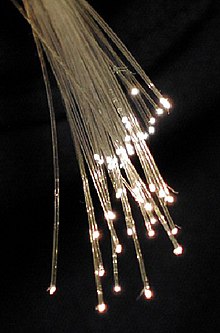
Back Glasvesel Afrikaans ليف زجاجي Arabic Шкляныя валокны Byelorussian Шкляныя валокны BE-X-OLD Стъклено влакно Bulgarian কাচ তন্তু Bengali/Bangla Fibra de vidre Catalan Skleněná textilní vlákna Czech Glasfiber Danish Glasfaser German

Fiberglass (also called fibreglass and glass fibre) is material made from extremely fine fibers of glass.
Fibreglass is cheaper and more flexible than carbon fibre. It is stronger than many metals (when compared by weight), and can be moulded into complex shapes. The plastic matrix is usually a thermoset polymer – such as epoxy or polyester resin, or it may be a thermoplastic.[1]
It is used as a reinforcing material for many polymer products. The composite material, that is produced by this method is called "fiberglass" in popular usage. The proper names are fiber-reinforced polymer (FRP) or glass-reinforced plastic (GRP).
Glassmakers throughout history have experimented with glass fibers, but mass manufacture of fiberglass was only made possible when finer tools for machines were produced. The first major use was in "glass wool" for insulation, starting in the 1930s.
Glass fiber is formed when silica-based or other formulation glass is extruded into many fibers with small diameters that are suitable for textile processing. Glass is unlike other polymers because, even as a fiber, it has little crystalline structure (see amorphous solid). The properties of the structure of glass in its soft stage are very much like its properties when spun into fiber.
- ↑ Mayer, Rayner M. 1993. Design with reinforced plastics. Springer. ISBN 978-0-85072-294-9